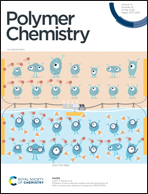LCST and UCST-type thermoresponsive behavior in dendronized gelatins†
Abstract
Modification of natural polymers with stimuli-responsive synthetic moieties is beneficial because of the convergence of superior properties from natural polymers and stimuli-responsiveness to generate new intelligent materials. This usually has been performed using synthetic polymers with long chains, resulting in modified natural polymers with diminished properties due to the predominant portion of synthetic moieties. In the present work, instead of long-chain polymers, we utilized threefold dendritic oligoethylene glycols (OEGs) for modification of gelatin, which is an important biomacromolecule with excellent biocompatibility and bioactivity, to generate dendronized gelatins (GelG1s) with radial amphiphilic features. The formed GelG1s can exhibit lower critical solution temperature (LCST)-type and upper critical solution temperature (UCST)-type thermoresponsive behavior, depending on the grafting ratio of the dendritic OEGs. The thermoresponsive behavior of GelG1s can further be tuned by the addition of salts. The introduction of dendritic OEGs results in only a minor influence on the secondary structure of the gelatins, and GelG1s retain the temperature-controlled sol–gel transitions that occur with the naked gelatin. In addition, the mechanical strength of the hydrogels formed from GelG1s at low temperatures can be modulated by either polymer concentration or grafting ratios of OEG dendrons. Overall, we provide a new strategy for the development of gelatin-based smart materials.



 Please wait while we load your content...
Please wait while we load your content...